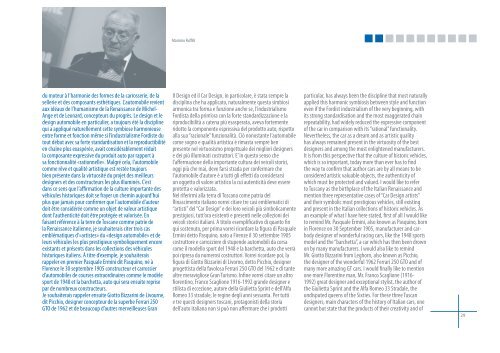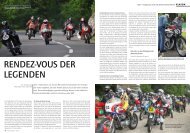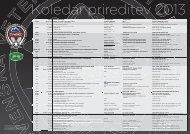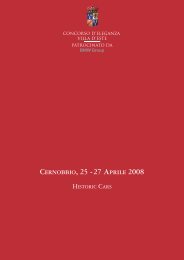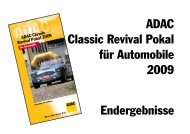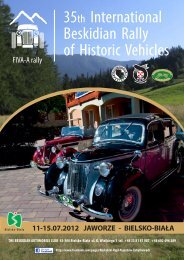Automotoclub Storico Italiano - Fédération Internationale des ...
Automotoclub Storico Italiano - Fédération Internationale des ...
Automotoclub Storico Italiano - Fédération Internationale des ...
You also want an ePaper? Increase the reach of your titles
YUMPU automatically turns print PDFs into web optimized ePapers that Google loves.
du moteur à l’harmonie <strong>des</strong> formes de la carrosserie, de la<br />
sellerie et <strong>des</strong> composants esthétiques. L’automobile revient<br />
aux idéaux de l’humanisme de la Renaissance de Michel-<br />
Ange et de Leonard, concepteurs du progrès. Le <strong>des</strong>ign et le<br />
<strong>des</strong>ign automobile en particulier, a toujours été la discipline<br />
qui a appliqué naturellement cette symbiose harmonieuse<br />
entre forme et fonction même si l’industrialisme Fordiste du<br />
tout début avec sa forte standardisation et la reproductibilité<br />
en chaîne plus exaspérée, avait considérablement réduit<br />
la composante expressive du produit auto par rapport à<br />
sa fonctionnalité «rationnelle». Malgré cela, l’automobile<br />
comme rêve et qualité artistique est restée toujours<br />
bien présente dans la virtuosité du projet <strong>des</strong> meilleurs<br />
<strong>des</strong>igners et <strong>des</strong> constructeurs les plus illuminés. C’est<br />
dans ce sens que l’affi rmation de la culture importante <strong>des</strong><br />
véhicules historiques doit se frayer un chemin aujourd’hui<br />
plus que jamais pour confi rmer que l’automobile d’auteur<br />
doit être considérée comme un objet de valeur artistique<br />
dont l’authenticité doit être protégée et valorisée. En<br />
faisant référence à la terre de Toscane comme patrie de<br />
la Renaissance italienne, je souhaiterais citer trois cas<br />
emblématiques d’»artistes» du «<strong>des</strong>ign automobile» et de<br />
leurs véhicules les plus prestigieux symboliquement encore<br />
existants et présents dans les collections <strong>des</strong> véhicules<br />
historiques italiens. À titre d’exemple, je souhaiterais<br />
rappeler en premier Pasquale Ermini dit Pasquino, né à<br />
Florence le 30 septembre 1905 constructeur et carrossier<br />
d’automobiles de courses extraordinaires comme le modèle<br />
sport de 1948 et la barchetta, auto qui sera ensuite reprise<br />
par de nombreux constructeurs.<br />
Je souhaiterais rappeler ensuite Giotto Bizzarini de Livourne,<br />
dit Picchio, <strong>des</strong>igner concepteur de la superbe Ferrari 250<br />
GTO de 1962 et de beaucoup d’autres merveilleuses Gran<br />
Massimo Ruffilli<br />
Il Design ed il Car Design, in particolare, è stata sempre la<br />
disciplina che ha applicato, naturalmente questa simbiosi<br />
armonica tra forma e funzione anche se, l’industrialismo<br />
Fordista della prim’ora con la forte standardizzazione e la<br />
riproducibilità a catena più esasperata, aveva fortemente<br />
ridotto la componente espressiva del prodotto auto, rispetto<br />
alla sua “razionale” funzionalità. Ciò nonostante l’automobile<br />
come sogno e qualità artistica è rimasta sempre ben<br />
presente nel virtuosismo progettuale dei migliori <strong>des</strong>igners<br />
e dei più illuminati costruttori. E’ in questo senso che<br />
l’aff ermazione della importante cultura dei veicoli storici,<br />
oggi più che mai, deve farsi strada per confermare che<br />
l’automobile d’autore è a tutti gli eff etti da considerarsi<br />
un oggetto di valore artistico la cui autenticità deve essere<br />
protetta e valorizzata.<br />
Nel riferirmi alla terra di Toscana come patria del<br />
Rinascimento italiano vorrei citare tre casi emblematici di<br />
“artisti” del “Car Design” e dei loro veicoli più simbolicamente<br />
prestigiosi, tutt’ora esistenti e presenti nelle collezioni dei<br />
veicoli storici italiani. A titolo esemplifi cativo di quanto fi n<br />
qui sostenuto, per prima vorrei ricordare la fi gura di Pasquale<br />
Ermini detto Pasquino, nato a Firenze il 30 settembre 1905<br />
costruttore e carrozziere di stupende automobili da corsa<br />
come il modello sport del 1948 e la barchetta, auto che verrà<br />
poi ripresa da numerosi costruttori. Vorrei ricordare poi, la<br />
fi gura di Giotto Bizzarini di Livorno, detto Picchio, <strong>des</strong>igner<br />
progettista della favolosa Ferrari 250 GTO del 1962 e di tante<br />
altre meravigliose Gran Turismo. Infi ne vorrei citare un altro<br />
fi orentino, Franco Scaglione 1916-1992 grande <strong>des</strong>igner e<br />
stilista di eccezione, autore della Giulietta Sprint e dell’Alfa<br />
Romeo 33 stradale, le regine degli anni sessanta. Per tutti<br />
e tre questi <strong>des</strong>igners toscani, protagonisti della storia<br />
dell’auto italiana non si può non aff ermare che i prodotti<br />
particular, has always been the discipline that most naturally<br />
applied this harmonic symbiosis between style and function<br />
even if the Fordist industrialism of the very beginning, with<br />
its strong standardisation and the most exaggerated chain<br />
repeatability, had widely reduced the expressive component<br />
of the car in comparison with its “rational” functionality.<br />
Nevertheless, the car as a dream and as artistic quality<br />
has always remained present in the virtuosity of the best<br />
<strong>des</strong>igners and among the most enlightened manufacturers.<br />
It is from this perspective that the culture of historic vehicles,<br />
which is so important, today more than ever has to fi nd<br />
the way to confi rm that author cars are by all means to be<br />
considered artistic valuable objects, the authenticity of<br />
which must be protected and valued. I would like to refer<br />
to Tuscany as the birthplace of the Italian Renaissance and<br />
mention three representative cases of “Car Design artists”<br />
and their symbolic most prestigious vehicles, still existing<br />
and present in the Italian collections of historic vehicles. As<br />
an example of what I have here stated, fi rst of all I would like<br />
to remind Mr. Pasquale Ermini, also known as Pasquino, born<br />
in Florence on 30 September 1905, manufacturer and carbody<br />
<strong>des</strong>igner of wonderful racing cars, like the 1948 sports<br />
model and the “barchetta”, a car which has then been drown<br />
on by many manufacturers. I would also like to remind<br />
Mr. Giotto Bizzarini from Leghorn, also known as Picchio,<br />
the <strong>des</strong>igner of the wonderful 1962 Ferrari 250 GTO and of<br />
many more amazing GT cars. I would fi nally like to mention<br />
one more Florentine man, Mr. Franco Scaglione (1916-<br />
1992) great <strong>des</strong>igner and exceptional stylist, the author of<br />
the Giulietta Sprint and the Alfa Romeo 33 Stradale, the<br />
undisputed queens of the Sixties. For these three Tuscan<br />
<strong>des</strong>igners, main characters of the history of Italian cars, one<br />
cannot but state that the products of their creativity and of<br />
29


